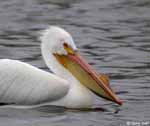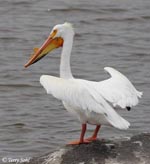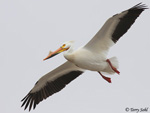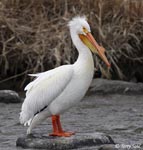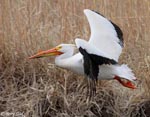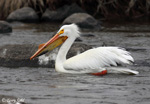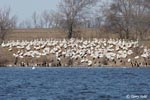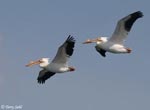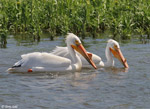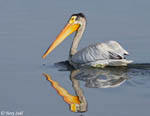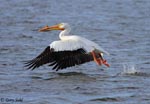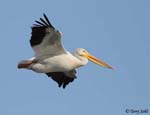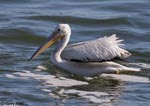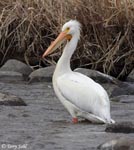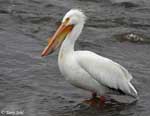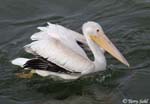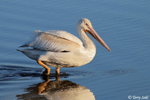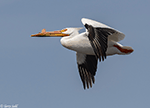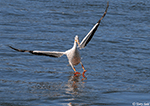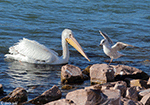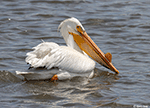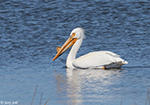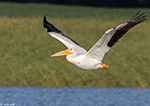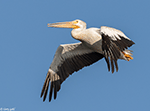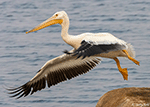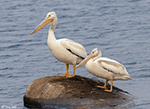American White Pelican
Pelecanus erythrorhynchos
| Length: 62 inches | Wingspan: 96 to 110 inches | Seasonality: Migrant / Summer |
| ID Keys: Distinctive. Very large size, all-white with black flight feathers, distinctive bill. | ||
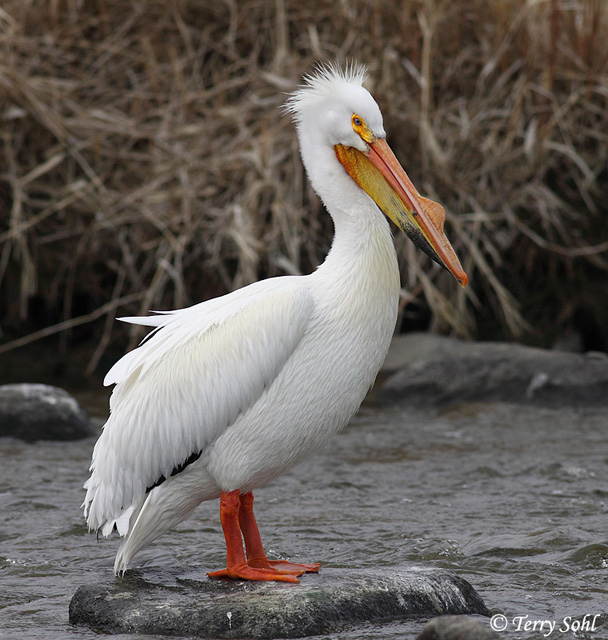 The American White Pelican
is one of the largest birds
found in South Dakota, and one of the heaviest flying birds in the world. They are migrants through most of the state, but do nest
in some of the northeastern counties. Unlike their cousins, the
Brown Pelican, American White Pelicans do not
plunge dive, but feed by dipping their large pouched bill into the water and
scooping up fish. Their massive bill and expansive pouch can hold up to 3
gallons of water, with the bird tipping the bill downward after a feeding scoop
to drain water, prior to swallow whatever fishy goody may have been caught
inside. Note the raised bump on the top of the beak (shown in
bird to the right, and in many of the photos below) is only present during the breeding season.
The American White Pelican
is one of the largest birds
found in South Dakota, and one of the heaviest flying birds in the world. They are migrants through most of the state, but do nest
in some of the northeastern counties. Unlike their cousins, the
Brown Pelican, American White Pelicans do not
plunge dive, but feed by dipping their large pouched bill into the water and
scooping up fish. Their massive bill and expansive pouch can hold up to 3
gallons of water, with the bird tipping the bill downward after a feeding scoop
to drain water, prior to swallow whatever fishy goody may have been caught
inside. Note the raised bump on the top of the beak (shown in
bird to the right, and in many of the photos below) is only present during the breeding season.
Habitat:
Lakes, marshes, rivers. Nests on isolated islands and sandbars, may feed many miles from nesting site.
Diet:
Mostly fish, also salamanders and crustaceans.
Behavior:
American White Pelicans feed by dipping their bill into the water and scooping up prey. They will often forage together in groups, lining up and driving prey fish to shallower waters for easier capture. While one of the heaviest flying birds, American White Pelicans are graceful in flying, often soaring on thermals in slow, ponderous, spiraling flight. The beautiful flight of an American Pelican was described by poet Aldo Leopold as follows:
"Let a squadron of southbound pelicans but feel a lift of prairie breeze...and they sense at once that here is a landing in the geologic past, a refuge from that most relentless aggressors, the future. With queer antediluvian grunts, they set wing, descending in majestic spirals to the welcoming wastes of a bygone age." - Aldo Leopold - Sand County Almanac
Nesting:
May through August. American White Pelicans are colonial nesters, usually nesting on isolated islands and sandbars that provide protection from predators. The nest of an American White Pelican is a depression on the ground, with a built-up rim of mud, rocks, and plants. The female lays 2 eggs, and both parents help to incubate them. Incubation lasts about a month, and when the eggs hatch, both parents help to feed the young. The young fledge at about 10 weeks.
Interactive eBird Map:
Click to access an interactive eBird map of American White Pelican sightings
Song:
Adult American White Pelicans are mostly silent, unless around the nesting site, or when feeling substantially threatened. Their vocalizations primarily consist of low, grunting or croaking noises. Young American White Pelicans at nesting colonies can be very vocal.
Migration:
Winters along Gulf Coast, California, and Mexico.
Similar Species:
Brown Pelican, in terms of general structure. However, plumage differences are obvious and the two are not likely to be confused with each other if seen well. Surprisingly, the American White Pelican is white, while the Brown Pelican is darker. You could even say it has a brownish hue to it. :-)
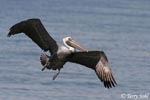 |
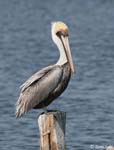 |
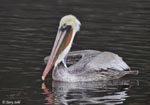 |
| Brown Pelican | Brown Pelican | Brown Pelican |
South Dakota Hotspot:
In eastern South Dakota in April and May, American White Pelicans are typically rather easy to find as they migrate to their breeding grounds. The larger lakes of the prairie potholes region of eastern South Dakota are good places to look, but smaller ponds and wetlands too will often hold American White Pelicans, provide there is adequate space for retaking flight, and prey are available. During the breeding season they can be found in and around many of the water bodies in the northeastern part of the state, including Sand Lake National Wildlife Refuge. In migration and during the post-breeding summer months, American White Pelicans are also often found below some of the Missouri River dams.
Status:
Due to habitat loss and disturbance at nesting colonies, populations declined substantially up through the middle part of the 20th century. Numbers have increased in the past few decades. The IUCN lists the American White Pelican as a species of "Least Concern".
Further Information:
- USGS Patuxent Bird Identification InfoCenter, American White Pelican
- Audubon Guide - American White Pelican
- Whatbird.com: American White Pelican
Photo Information:
April 21st, 2013 -- Lake Vermilion, South Dakota -- Terry L. Sohl
Additional Photos:
Click on the image chips or text links below for additional, higher-resolution American White Pelican photos.
Audio File Credits:
1Andrew Spencer. Recorded in Weld County, Colorado on June 27th, 2009. Original recording and information available from xeno-canto.
| Click on the map below for a higher-resolution view |
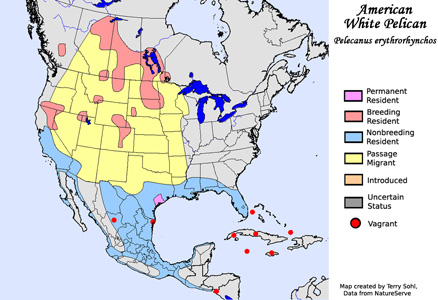 |
| South Dakota Status: Common migrant statewide. Common summer breeder in the northeastern part of the state, as well as in Bennett County. |
American White Pelican Photos
Click for a higher-resolution version of these photos
